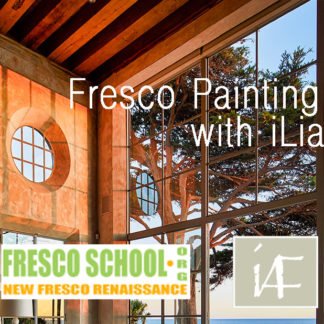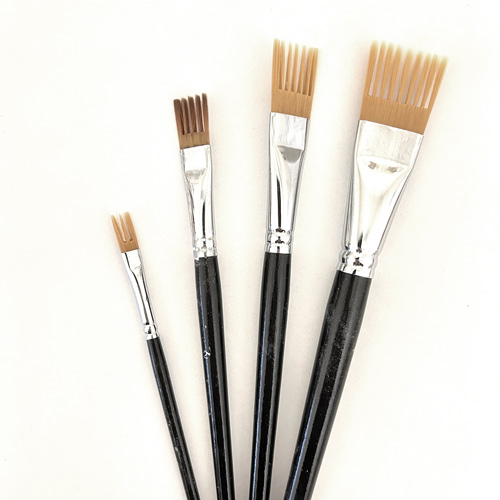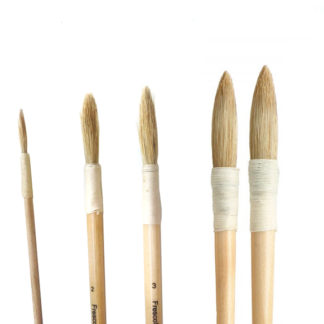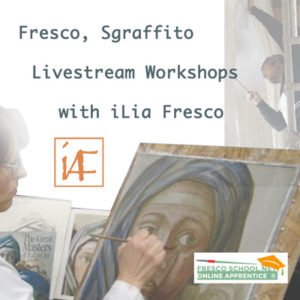Essentially, Sgraffito Plaster Coats are identical to Fresco Plaster Coats. Scratch Coat, Rough Coat, Float Coat, Arriccio (Brown) Coat and final, Intonaco Painting coat. The difference is that the “Arriccio” plaster coat is colored by addition of the pigment.
Optionally, arriccio plaster, can be fortified with either pozzolana and/or cocciopesto (brick dust). In contemporary practice Portland cement and/or polymers are widely used instead. Historically sgraffito is often combined with fresco painting and/or mosaic on the same wall (or panel) withing the same application.
Sgraffito Plaster Coats & Application
There are 3 distinct, foundational styles/methods in sgraffito technique, as defined by the Fresco School’s founder, iLia Anossov (fresco). They are: “Lace Sgraffito”, “Roman Sgraffito” (Roman 2-tone) and “Renaissance Sgraffito” (3-tone).
“Lace Sgraffito”
– this is a lace like two tone application where a coat of heavy lime paint is applied over toned arriccio or intonaco plaster coat as soon as it sets or even days after. Once paint sets the design is transferred and its negative areas are scraped. We offer Sgraffito Grip & Base and specially formulated Sgraffito Brush Topcoat for this method.
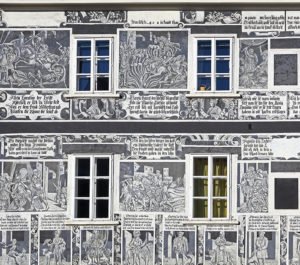
Brief How To: Use bristle brush, to apply a coat of Sgraffito Grip & Base or Gray plasterGrip (uncolored) over any surface and let dry over 24 hours. Follow with a coat of either Sgraffito Brush Topcoat and carve or another coat of Sgraffito Grip & Base and, once set (an hour or so), Sgraffito Brush Topcoat and carve.
“Roman Sgraffito” (2 tone)
– this is a similar to the “Lace Sgraffito” as in 2 tone effect, but instead of heavy lime paint a thin coat of roman marmorino (hence the name) is applied over toned arriccio plaster. It offers a much stronger layer and have 3 dimensional appearance. It has marble-like appearance as well as it can be painted in buon fresco with ample painting time window.
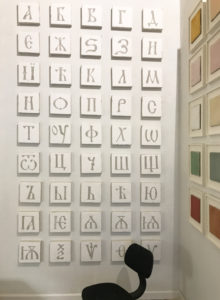
Brief How To: Use a trowel (I like 8×3 size trowel), to apply a thin coat of Sgraffito Marble Skim Topcoat or Roman Marmorino over fully cured toned arriccio or Sgraffito Grip & Base. Let it set, transfer design and carve.
“Renaissance Sgraffito” (3 tone)
– this is the most “dimensional” and most complex method. A thin layer of pigmented or raw intonaco is applied over fully cured toned arriccio plaster. Once set (within an hour), a thin coat of thinned Intonaco, or Sgraffito Marble Skim Topcoat plaster or Roman Marmorino is applied over and carved. The intermediate layer of the Sgraffito Sand Setting Intonaco plaster creates a halftone value in carved/sgraffito design. This method also provides the most time if details and entire compositions to be added in buon fresco as the sgraffito progresses.
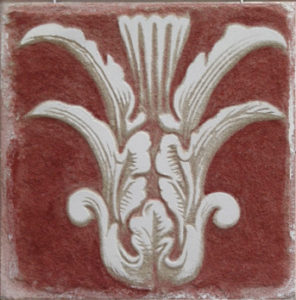
Brief How To: Use trowel (I like 8×3 size trowel), to apply a thin coat of “Sgraffito Sand Setting Intonaco” plaster and float flat with Fresco Wooden Float. Let set until firm to touch (about an hour or so). Apply a thin coat of a Sgraffito Marble Skim Topcoat or thinned Intonaco Plaster (best for elaborate details and compositions in buon fresco) let it set, transfer design, carve and paint.
See examples of Sgraffito Frescoes at Above The Clouds Icon Studio

